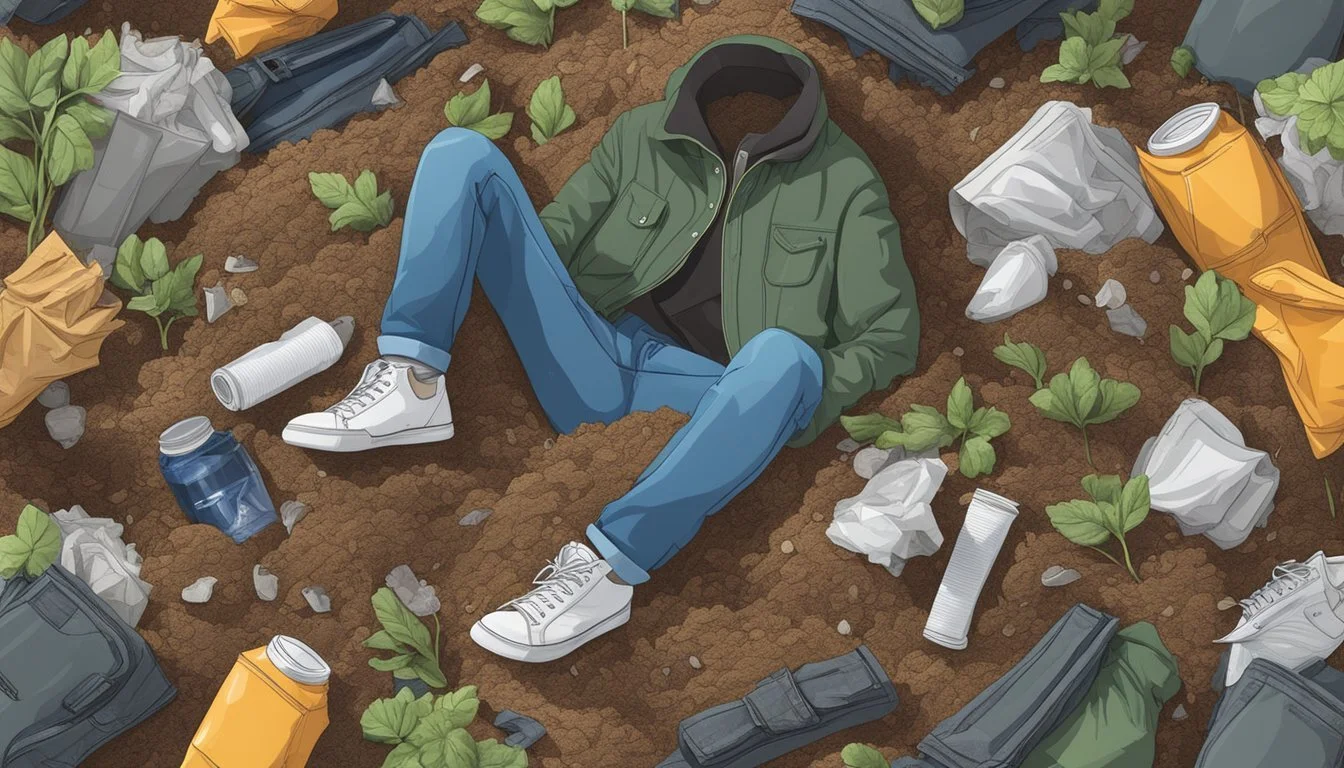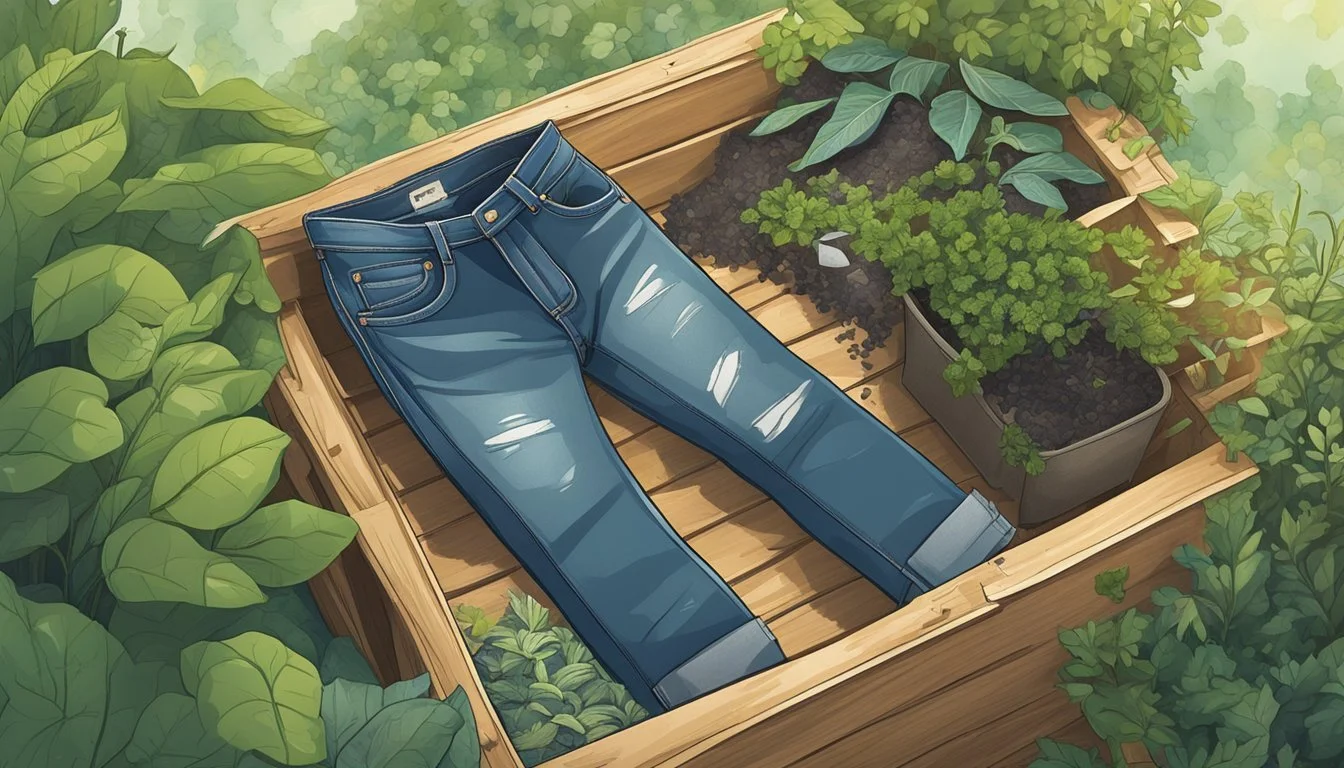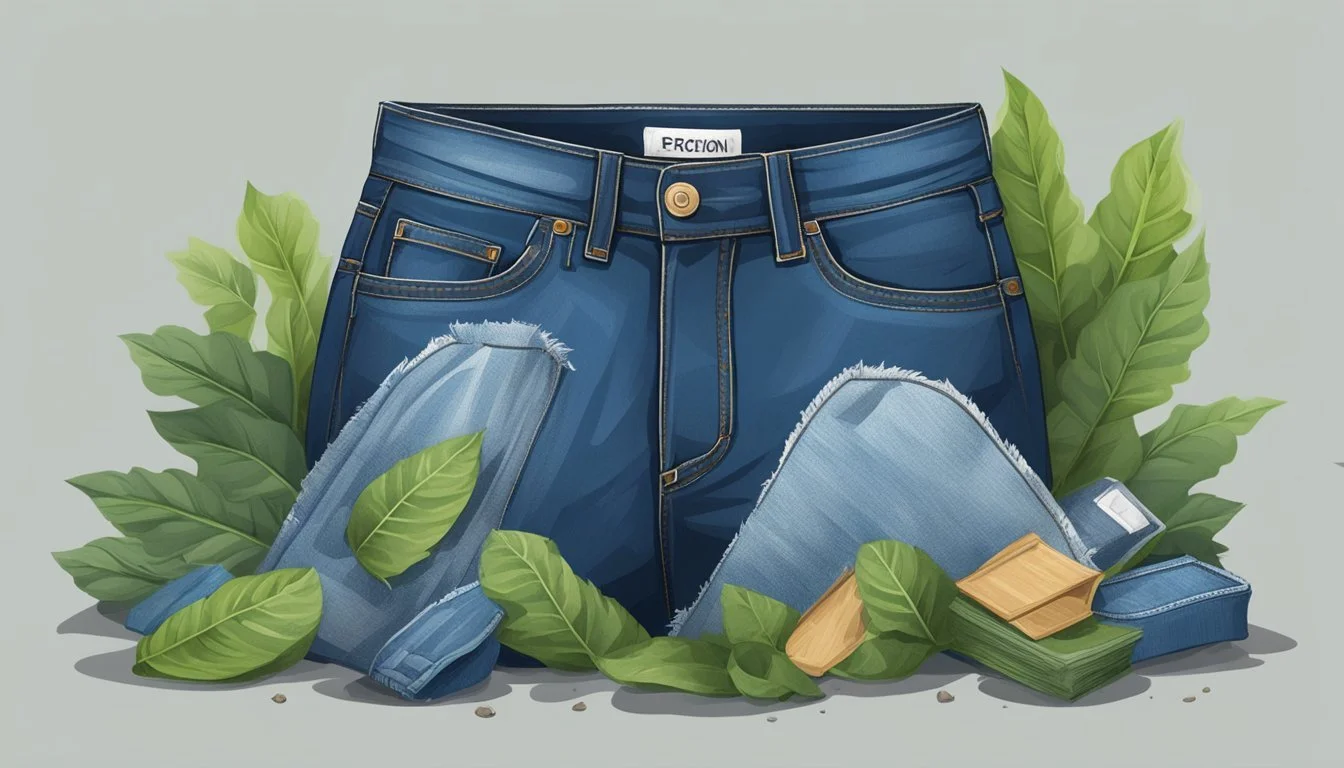Can You Compost Jeans?
Demystifying Fabric Recycling Options
Composting is an environmentally friendly method to recycle organic waste, and it naturally piques the curiosity of eco-conscious individuals looking to reduce their environmental footprint, especially in the fashion industry. When it comes to disposing of worn-out jeans, composting appears to be a viable option, given that jeans are primarily made of cotton, which is a natural, biodegradable material. The process of composting organic materials returns nutrients to the soil, supporting the growth of new plants and reducing the need for chemical fertilizers.
However, not all jeans can be composted equally. Traditional denim is compostable because it's made from natural fibers, but many modern jeans contain synthetic materials like elastane or polyester, which do not break down in a composting environment. The hardware on jeans, such as zippers and buttons, should also be removed before composting as they can contaminate the compost pile. It's imperative for consumers to consider the material composition of their denim to determine its suitability for composting.
For those interested in sustainable practices beyond composting, upcycling old jeans is an excellent way to repurpose the material into new fashion items or household textiles. Recycling denim conserves resources and energy that would otherwise be used to produce new fabric, aligning with the broader objectives of environmental conservation and sustainability within the fashion industry. Adopting such practices can lead to a significant positive impact on the environment by diverting waste from landfills and promoting a more circular economy in fashion.
Understanding Compost and Biodegradability
Compost is a key component in sustainable waste management, and understanding its interaction with biodegradable materials is essential. Analyzing how jeans can be part of this process highlights the steps toward reducing environmental impact.
What Is Compost and How Does It Work?
Compost is the result of decomposing organic matter, where microorganisms, fungi, and bacteria break down materials into nutrient-rich soil. The principle behind composting is to recycle organic waste, which includes certain textiles like natural fiber jeans, into a substance that can enrich soil.
Composting Components:
Greens: Provide nitrogen (e.g., fruit scraps, vegetables)
Browns: Provide carbon (e.g., dried leaves, twigs)
Water: Necessary for microbial activity
Oxygen: Fuels decomposition process
Biodegradable Materials in Composting
Materials that are classified as biodegradable can decompose naturally without harming the environment. In the context of composting, biodegradable items should break down into carbon dioxide, water, and biomass. For jeans to be compostable, they should be made of 100% organic materials like cotton, linen, or hemp. Any synthetic fibers or non-organic dyes can significantly impede the biodegradation process.
The Composting Process and Its Environmental Impact
The composting process involves layering organic waste in an environment conducive to decomposition. Through this process, composting transforms waste into a useful product that enhances soil health and structure. By integrating biodegradable materials like organic denim jeans into compost, they not only reduce waste but also contribute to the creation of a natural fertilizer that supports plant growth and restores vital soil nutrients.
Key Environmental Benefits:
Reduces landfill waste: Composting organic materials reduces the volume of waste sent to landfills.
Lowers greenhouse gas emissions: Proper composting lowers methane emissions from landfills.
Enhances soil quality: Compost adds essential nutrients back into the soil.
Promotes sustainable practices: Encourages the creation and use of organic and biodegradable products.
Materials Used in Jeans Manufacture
Traditionally, jeans are crafted from denim, a sturdy cotton twill fabric. Cotton is the primary natural fiber used in denim production due to its durability, comfort, and breathability. However, jeans are not limited to just cotton. In some cases, textiles like wool, linen, and hemp may be incorporated to achieve different textures and properties.
In the evolving landscape of jeans manufacture, synthetic fibers such as nylon and polyester are sometimes blended with natural fibers to enhance functionality. The addition of these synthetic materials can improve the elasticity, reduce shrinkage, and extend the life-span of the jeans.
High-end jeans might also include silk, adding a luxurious feel to the rugged denim. For those with environmental concerns, organic cotton is an option that reduces the impact on the ecosystem, as it avoids the use of synthetic pesticides and fertilizers in its cultivation.
Natural Fibers Synthetic Fibers Cotton Nylon Wool Polyester Linen Hemp Organic Cotton (Option) Silk (In select premium jeans)
It's important to note that the material composition affects compostability. Jeans made purely from natural fibers like cotton or organic cotton can decompose in a compost setting, whereas those containing synthetic fibers would need separation due to their non-biodegradable nature.
Factors Affecting Compostability of Jeans
Composting jeans is contingent upon the materials used in their construction and treatments applied during manufacturing. These variables can significantly impact the degradation rate and overall compostability of the garment.
The Role of Fabric Type and Compostability
Jeans are traditionally made from cotton, a natural fiber that is inherently compostable. However, modern jeans often contain a blend of materials, including synthetic fibers like polyester or elastane, which do not break down as readily in a composting environment. Jeans made from pure cotton or other natural fibers such as ramie are more conducive to composting. In contrast, blends may require more judgment call to determine if they can be effectively composted.
Non-Fabric Components and Their Effects
Jeans typically come equipped with various non-fabric components such as metal buttons, zippers, and rivets. Before composting, one should remove these items because they do not decompose and can contaminate the compost with metals. The thread used for stitching may also be problematic if it is made from synthetic materials; only threads made from natural materials should be present in compostable jeans.
Dyes and Chemical Treatments Influence
The compostability of jeans is also influenced by the dyes and chemical treatments they undergo. These substances can affect the biodegradability of the fabric and potentially introduce toxins into the compost. It's essential to ensure that the dyes used are non-toxic and that any chemical treatments do not hinder the composting process. If the jeans contain harmful chemicals or dyes, they should not be added to compost to avoid potential soil and environmental contamination.
Practical Guide to Composting Jeans
Composting jeans is a sustainable way to dispose of old clothes, particularly those made from cotton. Proper preparation and understanding textiles' role in maintaining compost balance are essential.
Preparing Jeans for Composting
Before adding jeans to the compost heap, one must prepare them properly to ensure efficient decomposition. Start by removing any non-compostable components such as zippers, buttons, or patches that may contain synthetic materials. Jeans are primarily cotton, a carbon-rich material, but they often have stitching or embellishments made from non-biodegradable materials.
Buttons/Zippers: Remove and set aside for recycling or repurposing.
Synthetic Parts: Cut out any polyester threads or synthetic labels.
Size Reduction: Cut the cotton fabric into smaller pieces to expedite the composting process.
Composting Techniques for Textile Fibers
When composting jeans, one should incorporate them into the compost pile as 'brown' materials, which are carbon sources. They will offset the 'green' nitrogen-rich substances like food scraps.
Layering Method:
Step 1: Place a layer of brown material at the bottom of the compost bin.
Step 2: Add a layer of green material on top of the browns.
Step 3: Intersperse small cut-up pieces of denim within the browns.
This alternating layer structure aids microorganisms' access to both types of materials, encouraging a more efficient breakdown of the fibers.
Maintaining the Compost Balance
A successful compost requires a proper ratio of nitrogen to carbon. Jeans, being high in carbon, must be balanced with sufficient nitrogen-rich materials.
Ratio:
Ideal Carbon to Nitrogen Ratio: Aim for a ratio of roughly 25-30 parts brown (carbon) to 1 part green (nitrogen).
Regularly turning the compost pile ensures an even breakdown of materials and adequate oxygen flow, crucial for the composting process. Monitor the heap for moisture levels, as too much water can slow down decomposition whereas too little can halt it.
Moisture Management: The compost should feel like a wrung-out sponge – damp but not dripping.
Aeration: Turn the pile every few weeks to prevent compacting, which can lead to anaerobic conditions.
By adhering to these practices, one can effectively compost jeans and contribute to a reduction of textile waste.
Common Materials in Compost Bins
In composting, a balance of 'greens' and 'browns' is essential. Greens are nitrogen-rich materials, such as vegetable scraps, fruit peelings, and coffee grounds along with their filters. These items add necessary moisture and nutrients to the compost pile. Kitchen waste, often consisting of fruit and vegetable remains along with tea bags and eggshells, is a staple of composting.
Browns, on the other hand, provide carbon. These include stale bread, tofu, stale cereal, and corn cobs. Certain paper products like toilet paper, paper towels, and plain paper napkins fall into this category as well, provided they are not coated with plastic or ink. Cereal boxes and pizza boxes, once shredded, can be included but must be free from plastic lining and excessive grease.
Not all kitchen waste is suitable; for instance, meat and fish are commonly excluded to avoid pests and odors. Jell-O and dairy products are also typically omitted as they can create odors and attract pests.
Flowers and garden waste like fallen leaves can be composted, whereas treated plant material should be avoided. Earthworms, often found naturally in compost bins, are beneficial for their ability to break down organic material and for aerating the pile.
Here is a concise list of recommended items for compost bins:
Greens:
Fruit and vegetable scraps
Tea bags (non-plastic)
Coffee grounds and filters
Fresh grass clippings
Browns:
Dry leaves and twigs
Paper products (uncoated)
Cardboard (shredded, no ink or plastic)
Stale bread and cereals
Items like paper plates should only be composted if they do not have a waxed or plastic coating. Furthermore, a thriving compost pile needs sufficient aeration, consistent moisture, and occasional turning to expedite the decomposition process efficiently.
What Not to Compost
When composting jeans or any textiles, it is crucial to recognize materials that do not break down easily or could contaminate the compost. Hazardous items and synthetic materials should be avoided to ensure a healthy composting process.
Hazardous and Non-Compostable Jeans Materials
Jeans often contain materials that are not suitable for composting. Synthetic fibers, such as polyester or elastane, are common in jeans designed to be stretchy or to have a specific fit. These materials do not biodegrade and can persist in the environment, so they should be removed before any part of a jean item is composted.
Paints and Dyes: Some jeans are treated with paints or dyes that contain hazardous chemicals. These can leach into the soil and harm the microbial life essential for composting.
Metal Components: Elements like zippers and rivets do not decompose and could also introduce rust or other contaminants.
Contaminated Fabrics: Jeans soiled with oil, like engine oil, should not be composted, as oil can disrupt the composting process and harm beneficial organisms.
Non-Biodegradable Items to Avoid
In addition to the non-compostable parts of jeans, other items commonly found around the house should not make their way into a compost pile. These include:
Plastics: Any form of plastic is non-biodegradable, whether it's buttons from clothing or plastic wrappers.
Synthetic Fibers: All synthetic fabrics, not just those in jeans, should be excluded from compost piles.
Composting is an effective way to recycle organic waste, but it requires careful consideration of what materials are added. By avoiding these non-compostable items, individuals can create nutrient-rich compost that is safe for their gardens and the environment.
Composting in Various Settings
When composting jeans or other organic materials, the approach may vary depending on the setting, whether it is a residential backyard or an industrial facility. Each has its own techniques and considerations to maximize the efficacy of composting while minimizing environmental impact.
Residential Backyard Composting Tips
Backyard composting offers a personal touch to waste management, allowing individuals to convert their organic waste, including denim jeans made from natural fibers like cotton, into nutrient-rich soil. Here are key points to remember:
Balance: Maintain a healthy balance between greens (nitrogen-rich materials) and browns (carbon-rich materials) to ensure proper composting. Jeans can add carbon to the mix.
Aeration: Regularly turn the compost pile to introduce air into the system, which accelerates the breakdown process and prevents foul odors.
Moisture: Keep the compost moist, like a wrung-out sponge, to support the microorganisms breaking down the material.
Industrial Composting Techniques
Industrial composting processes operate on a larger scale and can handle greater quantities of organic waste, including textiles from a farm or manufacturing source. These facilities utilize advanced techniques for efficient decomposition:
Temperature control: Industrial composting maintains higher temperatures to speed up the decomposition, effectively breaking down tougher organic materials.
Mechanical processing: Facilities often use machinery to churn and aerate the compost, ensuring uniform decomposition throughout the large volumes of waste.
Processing times: While backyard composting may take several months to a year, industrial setups can complete the process in a few weeks, optimizing the cycle of returning organics back to the soil.
Eco-Friendly Practices Beyond Composting
Aside from composting, there are other robust methods for managing old denim jeans in an eco-friendly manner. These practices not only reduce landfill contribution but also promote sustainability and innovation in textile waste management.
Creative Reuse and Upcycling of Denim
Upcycling transforms old jeans into new, usable items, extending their life cycle and minimizing waste. Creative individuals and businesses alike turn denim into a variety of products such as:
Home Insulation: Denim's durable cotton material serves as an effective, non-toxic insulator.
Fashion Accessories: Belts, bags, and hats crafted from old jeans create less demand for new raw materials.
Home Décor: Denim can be used to make unique upholstery, cushion covers, and quilts, adding character to interiors.
These upcycled items keep the fabric out of landfills and demonstrate innovative applications for textile waste.
Recycling and Waste Reduction Efforts
Recycling denim involves breaking down the fabric to reclaim the fibers for new textile production. Companies dedicated to sustainability may use:
Mechanical Processes: To separate cotton fibers from other blended materials for reuse.
Chemical Processes: For higher efficiency in breaking down complex materials, although this is less eco-friendly.
Beyond recycling, reducing waste is critical. Consumers and manufacturers can focus on:
Eco-Friendly Alternatives: Choosing jeans made with sustainable materials like organic cotton or recycled fibers.
Quality Over Quantity: Investing in well-made denim that withstands trend cycles helps reduce the frequency of disposal.
By reusing and recycling denim, individuals and companies can significantly minimize their environmental impact, moving towards a more sustainable future.










